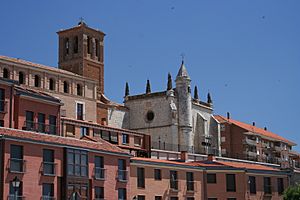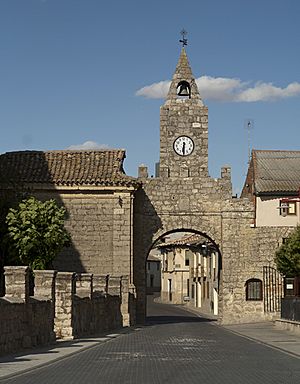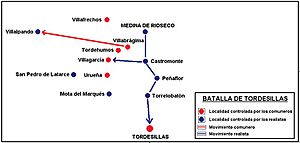Battle of Tordesillas (1520) facts for kids
Quick facts for kids Battle of Tordesillas |
|||||||
|---|---|---|---|---|---|---|---|
| Part of Revolt of the Comuneros | |||||||
 View of Tordesillas, site of the battle. |
|||||||
|
|||||||
| Belligerents | |||||||
| Comuneros | Royalists | ||||||
| Commanders and leaders | |||||||
|
Pedro Girón y Velasco |
Count of Haro | ||||||
| Strength | |||||||
|
4000 infantrymen |
± 7000 infantrymen |
||||||
| Casualties and losses | |||||||
| Unknown | 50, including dead and injured | ||||||
|
Consequences:
|
|||||||
The Battle of Tordesillas was an important fight during the Revolt of the Comuneros in Spain. It happened on December 5, 1520, in the town of Tordesillas. This town was a main base for the Comuneros, who were rebels fighting against the king.
The battle was between the royalist army, led by the Count of Haro, and the Comunero soldiers defending Tordesillas. The royalists won, which was a big setback for the Comuneros. They lost control of Tordesillas, which was important because Queen Joanna was living there. The Comuneros had hoped she would support their cause.
After this defeat, many Comunero leaders were captured or had to run away. Their main general, Pedro Girón y Velasco, resigned because of criticism. This caused many Comunero soldiers to leave the fight.
Even though the royalists won, they didn't fully use their victory. They were divided and worried about their own lands. So, they just set up small forts in some places and sent most of their soldiers home.
Contents
Why the Battle Happened
In late November 1520, the Comunero army, led by Pedro Girón, moved its main forces to Villabrágima. This brought them very close to the royalist army, which was in Medina de Rioseco. Everyone expected a fight.
However, the royalist leaders, mostly nobles, didn't want to attack right away. They were divided. Some, like the regent Adrian, wanted a quick attack. They believed their army was stronger. But the nobles thought it was too risky. The ground was difficult for their cavalry, which was their main strength.
Also, the nobles were worried about their own lands. They feared that if they fought the Comuneros too hard, their own people might rebel against them. They argued a lot about what to do.
The Armies
It's hard to know the exact number of soldiers in each army, but we can get an idea from letters written at the time.
- Royalist Army: This army was led by the Count of Haro. Most of their soldiers were foot soldiers (infantry) recruited by nobles from places like Navarre, Galicia, and Asturias. They also had some experienced soldiers from a previous war in Djerba. They had about 20 pieces of artillery (cannons).
- Comunero Army: This army was made up mostly of city soldiers (militias) from cities like Valladolid, Toledo, and Segovia. They also had some Djerba veterans. A unique part of their army was a group of about 300 armed priests led by Bishop Antonio de Acuña from Zamora. They got their weapons and cannons from places like Medina del Campo.
The Battle Begins
On December 2, the Comunero army left Villabrágima and moved towards Villalpando. This move left the path to Tordesillas unprotected. Tordesillas was very important because it was the Comunero headquarters and where Queen Joanna lived.
The royalist army quickly saw this chance. On December 4, they marched towards Tordesillas. They took over nearby villages easily, with only small fights in Villagarcía.
Fall of Tordesillas
On December 5, the first royalist soldiers reached Tordesillas around 10 AM. The Count of Haro arrived with the rest of the army a few hours later. He sent a message to the Comuneros in Tordesillas, telling them to surrender. The Comuneros asked for more time, hoping for reinforcements to arrive. But the Count of Haro refused.
At 3:30 PM, after heavy cannon fire, the royalists began their attack. The Comunero soldiers, about 400 foot soldiers and 80 lances (cavalry), fought bravely. Some of them were the armed priests from Zamora. They defended the city fiercely.
After about an hour of fighting, a royalist soldier managed to open a gate in the city wall. The attackers rushed in. The Comuneros tried to stop them by setting fire to nearby houses. Fighting continued in the streets, hand-to-hand, with bells ringing and fires burning.
Captain Suero del Águila arrived with 100 lances to help the Comuneros, but the royalist army was too strong. He was captured. Around 8 PM, the last Comunero defenders gave up.
The royalist soldiers then began to loot the city. Only churches, convents, and Queen Joanna's home were spared. Even the saddle of Princess Catherine was stolen. The noble leaders were upset by this, but said they couldn't control their men.
The royalists reported only about 50 casualties (dead and injured). This number seems very low for such a long and fierce fight. Some royalist leaders, like the Count of Benavente, were injured.
What Happened to Girón?
There was some debate among historians about whether Pedro Girón, the Comunero general, betrayed the rebel cause when he moved his troops away from Tordesillas.
Some historians believed he secretly agreed with the royalists to let them take Tordesillas. They thought he wanted to get a pardon from the king. However, there is no strong proof of this. After the battle, Girón did not join the royalist side. He went to Valladolid, the new Comunero capital, to continue fighting. He only resigned later because of rumors among his soldiers, not because he was distrusted by other leaders.
Historians today often think that Girón and the Comunero leaders simply made a mistake. They believed the royalists would not attack Tordesillas. Instead, the royalists took advantage of the unprotected route.
Consequences
The royalist victory at Tordesillas had big effects on the Comuneros, but it didn't end the rebellion. In fact, many rebels became even angrier. They started to criticize the nobles more and even thought about attacking their lands.
The royalists, despite their victory, didn't push their advantage. They were still divided and worried about money. They just set up small forts in important places like Simancas and Torrelobatón, then sent most of their soldiers home.
For the Comuneros
- Political Impact: The Comuneros lost Tordesillas, which meant they lost the chance to use Queen Joanna's authority to support their cause. Many of their leaders were captured. The Santa Junta, their main governing group, became smaller. Only 10 cities were represented at their next meeting in Valladolid, which became their new capital.
- Military Impact: The Comunero army lost its main leaders. Girón resigned, and Bishop Acuña also left. Many soldiers deserted. By early 1521, the Comunero army was half the size it had been before the battle. They wanted to retake Tordesillas, but it never happened.
For the Royalists
- Military Impact: The royalists won, but they didn't follow up on their victory. They should have marched on Valladolid, but they didn't. They were short on money and didn't want to keep a large army. Most of the nobles went back to their own lands.
- Political Impact: The royalist side was not united. Some wanted to negotiate with the rebels, while others wanted to crush them. Cardinal Adrian criticized the nobles for caring more about their own interests than the king's. This lack of unity meant they didn't fully use their victory at Tordesillas.
See also
 In Spanish: Batalla de Tordesillas para niños
In Spanish: Batalla de Tordesillas para niños
Images for kids
-
Portrait of Adrian of Utrecht, who encouraged the nobles to attack Tordesillas.




